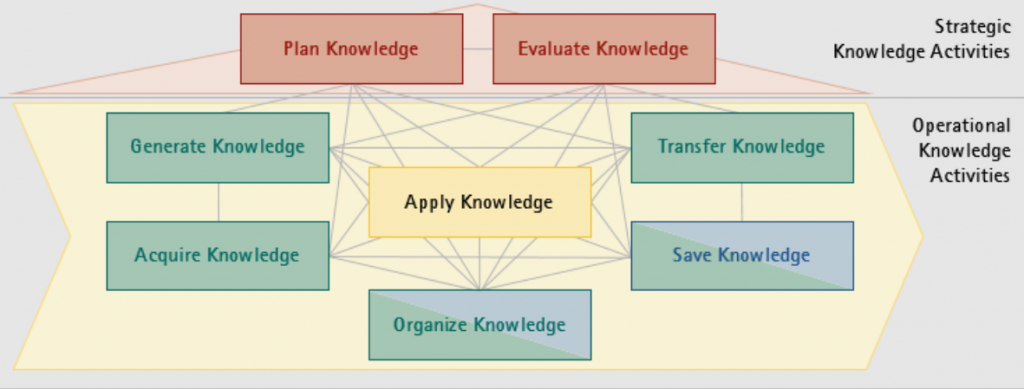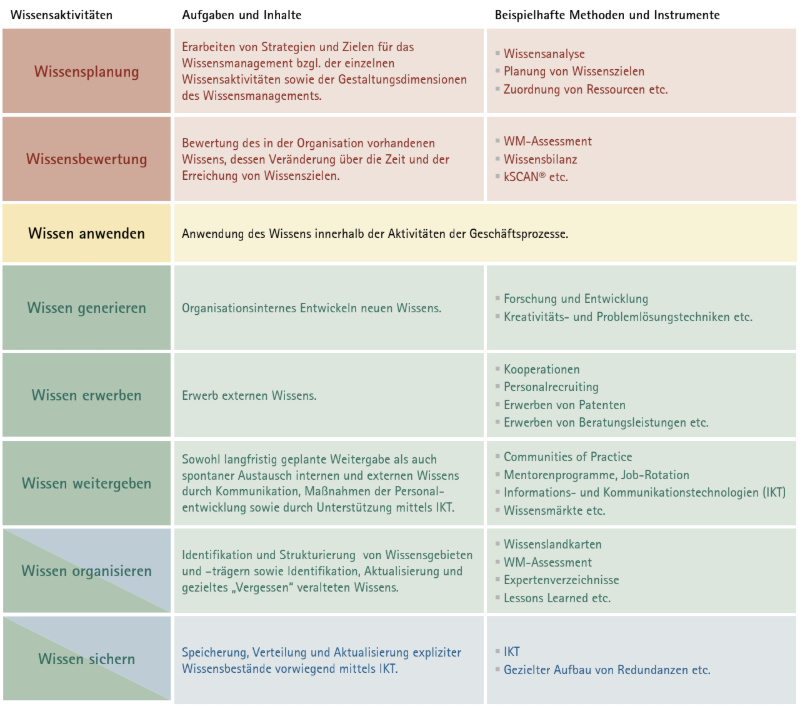by Sebastian Dennerlein, Robert Gutounig & Stefan Schweiger
The model of knowledge activities has been an essential part of Wissensmanagement Forum`s knowledge management handbook from 2007 (Wissensmanagement Forum 2007). Since then it has been applied and validated in numerous occasions where knowledge management has been implemented or taught. As part of the handbook’s renewal, the model of knowledge activities is re-examined in order to address necessary redefinitions, extensions and clarifications. To make it accessible to an international audience we also make present the first English version here in this article.
The model of knowledge activities was originally based on Probst’s building blocks of knowledge management (Probst 2002). It is a model to identify and analyse the organizational and individual processes with respect to knowledge management (Wissensmanagement-Forum 2007). They are divided into strategic and operational activities. Especially the five operational knowledge activities allow for an analysis of knowledge management related benefits. In Figure 1, the knowledge activities are illustrated, in Figure 2 you see a short description taken from the organizational context.  Figure 1: Knowledge activities (based on Probst et al. 2002)
Figure 1: Knowledge activities (based on Probst et al. 2002)
 Figure 2: Knowledge activities – Contents and supporting methods & instruments
Figure 2: Knowledge activities – Contents and supporting methods & instruments
Here we state what we find needs updating and the current status of discussion:
- Knowledge generation: Knowledge generation has been seen so far predominantly as an internal process, without external stimulation. Here we want to differentiate into internal and external knowledge generation: i.e. knowledge is created within the organization by employees or knowledge is created together with partners or customers, thus “externally”. Besides this, we are thinking about renaming knowledge generation to knowledge “creation”, since this stresses the fact of the creation of new knowledge in comparison to the construction of existing knowledge. This renaming would enable to highlight the collaborative processes of knowledge building as well: “(co-)creation” of knowledge.
- Knowledge transfer: We understand knowledge transfer in terms of knowledge sharing processes, which are practiced widely in Web 2.0 contexts (for example mash up ways of sharing, memes etc.). In particular we suggest that there is an influence of sharing processes on knowledge transfer and this interplay has to be taken into consideration and analyzed.
- Knowledge organization: The organization of knowledge can – as is the case with knowledge generation – happen in a joint team effort. This is why we will investigate the effects of collaborative knowledge organization on knowledge management: for example, collaborative knowledge organization is reflected by building taxonomies collectively with a wiki software.
- With respect to overall model, we want to respect the sequential influence of the knowledge activities and propose an order for effective knowledge circulation: knowledge acquisition → (co-)organization → (co-)creation → saving → sharing → knowledge acquisition. This loope, spiral-like model will be repeated iteratively, whereby the involved knowledge is maturing, and at the same time, the existing knowledge base is extending. Besides the clear depiction of the mechanisms of interaction, the new model will relate the knowledge activities to the model of interdisciplinary teamwork (Kraker & Dennerlein, 2013). For example, collaborative as well as cooperative phases with respect to the knowledge activities, as well as organization and generation model of knowledge circulation will be included.
The revision of this model should help to apply it to measure the effectiveness of KM tools (offline & online). A variant of the model could help to analyze of the impact of Web 2.0 models, methods and tools on knowledge management. A lot of instances of these tools are already implemented in many organisations and help teams to communicate more efficiently. Among these tools are for example Yammer, more recently also Slack,Skype, Hangouts Chat grape), Whatsapp, Snapchat, Facebook messenger and many more.
Finally, we will discuss the upcoming model of knowledge circulation in relation to one of the most influential models in KM, Nonaka´s SECI model of knowledge dimensions (Nonaka / Takeuchi 1995), to also respect implicit and explicit processes of knowledge management. In this way we aim at mutual inspiration and obtaining a sound basis for different kinds of KM applications.
References:
- Kraker, P., & Dennerlein, S. (2013). Towards a Model of Interdisciplinary Teamwork for Web Science: What can Social Theory Contribute?. In Web Science 2013 Workshop: Harnessing the Power of Social Theory for Web Science.
- Nonaka, I., & Takeuchi, H. (1995). The Knowledge-creating Company: How Japanese Companies Create the Dynamics of Innovation. Oxfors, New York: Oxford University Press.
- Probst, G., Raub, S. & Raub, K (2002). Managing knowledge: building blocks for success. Chichester: Wiley.
- Wissensmanagement Forum (Hrsg.). (2007). Das Praxishandbuch Wissensmanagement.Integratives Wissensmanagement. Graz: Verl. der Techn. Univ.
 Figure 1: Knowledge activities (based on Probst et al. 2002)
Figure 1: Knowledge activities (based on Probst et al. 2002)
 Figure 2: Knowledge activities – Contents and supporting methods & instruments
Here we state what we find needs updating and the current status of discussion:
Figure 2: Knowledge activities – Contents and supporting methods & instruments
Here we state what we find needs updating and the current status of discussion:
